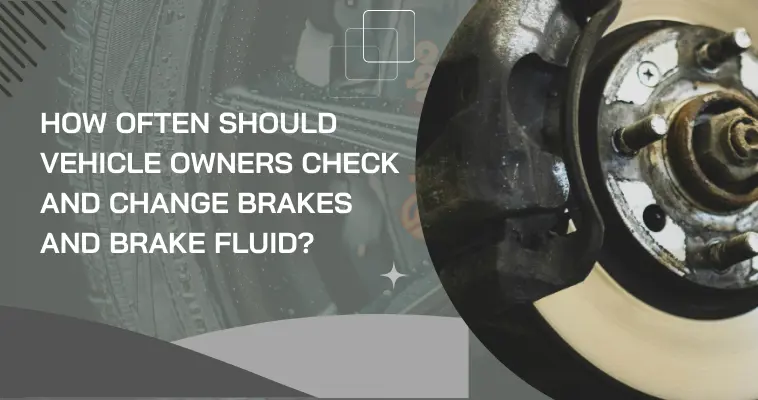Once upon a time, cars used cable-operated brakes to stop. In the future, electric systems will likely be used instead.
But for now, cars mostly rely on hydraulic brake fluid.
The hydraulic system plays a pivotal role in the transfer of energy, as it pumps brake fluid through a channel. When the driver presses the brake pedal, the fluid is propelled from the master cylinder through a line to a brake calliper or brake cylinder.
This hydraulic pressure either squeezes the brake calliper halves together or expands brake shoes to touch a rotating drum fixed to the wheel.
In disc brakes, the calliper clamps the brake pads to a rotor (disc) attached to each wheel. This pressure on the rotor slows the wheel's rotation and stops the car.
To get your vehicle’s brakes inspected, you can go to a brake replacement centre near you.
Understanding brake cylinders and fluids
Brake cylinders (the master cylinder on the firewall and slave cylinders at the wheels) use hydraulic pressure to operate the car's drum brakes if it has them. The pressure in the slave cylinder pushes a piston, which forces the brake shoes outward. This increases the friction between the shoes and the drum attached to the wheel, slowing the wheel and stopping the car.
Over the years, brake fluid has included castor oil, alcohol, glycol ether (often mixed with borate ester), mineral oil, and silicon. All these fluids boil at much higher temperatures than water, at least 140° Celsius. This is important because braking generates a lot of heat when converting motion into heat through friction.
Brake fluid should not boil under normal conditions, should not compress and should not corrode the braking system's internal parts.
If you aren’t sure of how brake cylinders and fluids work, get in touch with an expert car brakes service centre near you.
Signs you need a brake fluid replacement
Regular maintenance is crucial for manual transmission vehicles with hydraulic clutches, which should be flushed periodically to ensure optimal performance and prevent potential issues.
If you notice any of the following, it may be a sign that you need to replace your brake fluid before the recommended two-year interval:
- Your brake pedals feel soft or spongy.
- The brake fluid looks darker, sludgy, or dirty.
- Your vehicle is leaking brake fluid.
- The brake warning light on your dashboard is on.
- You don't remember the last time your brake fluid was flushed.
Key benefits of regular brake fluid replacements
Replacing your old brake fluid with fresh fluid offers several benefits. Vehicle owners often ask, ' How often should I get my brakes checked?’ Let’s first understand its benefits.
- Prevents major repairs: Regular brake fluid service helps you avoid expensive brake repairs in the future.
- Prevents minor issues from escalating: It helps prevent minor braking issues from becoming larger, potentially dangerous problems.
Over time, brake fluid becomes saturated with moisture, reducing brake performance and compromising safety. By getting a brake fluid change, you:
- Maintain brake quality: Ensure your braking system has maximum hydraulic transmitting capacity.
- Improve safety: Gain confidence to stop your car suddenly if needed.
Additional benefits of a brake fluid change every two years include:
- Prevent moisture build-up: Minimise the likelihood of internal brake corrosion.
- Protect internal components: Prevent significant damage to the brake system's internal components and valves caused by moisture absorption.
A brake fluid flush, which replaces old fluid with fresh fluid, will:
- Remove excess moisture: Improve overall pedal feel and brake performance.
- Boost vehicle safety : Regular brake fluid replacements are not just a one-time fix. They are an important routine that helps your car stop confidently, ensuring safety for you, your family, pedestrians, and other road users.
DIY tips for brake fluid change by vehicle owners
Changing brake fluid can vary slightly between cars, but the general steps are the same. It's best to have a helper for this task, as they can assist with pressing the brake pedal. Here's a simple guide:
1. Drain the old brake fluid
Remove the cap from the brake master cylinder.
Use a syringe or similar tool to suck out as much old brake fluid as possible and put it in a suitable container.
To access the brakes, lift the car on axle stands and remove all four wheels.
2. Add new brake fluid
Clean the brake master cylinder reservoir with a lint-free cloth to remove any debris.
Fill the reservoir with new brake fluid up to the MAX line. Use fluid from a sealed container to avoid moisture contamination. Check your car's manual for the correct type of brake fluid.
3. Flush the callipers/Wheel cylinders
Locate the bleed nipple on each brake calliper or wheel cylinder.
Spray brake cleaner and penetrating oil on the nipple to clean off-road dirt.
Attach a small rubber hose to the nipple and submerge the other end in old brake fluid in the container.
4. Get some help
Place a block under the brake pedal to prevent it from being pressed too far.
With your helper in the driver's seat, open the bleed nipple on the farthest calliper or wheel cylinder from the master cylinder.
Have your helper press the brake pedal ("DOWN") and then release it ("UP"). Close the nipple after each pedal press to avoid sucking air into the system.
Continue until you see new brake fluid without air bubbles from the nipple.
5. Top up the brake fluid
Monitor the brake fluid level in the master cylinder and top it up as needed.
Avoid letting the level drop too low, which can introduce air into the system.
6. Repeat and finish
Repeat the process on each calliper or wheel cylinder, moving closer to the master cylinder.
Check the brake pedal feel; it should be firm if the system is properly filled with new fluid.
Check the master cylinder level one last time, top it off if needed, and then close the reservoir.
Reattach the wheels and lower the car.
Dispose of the old brake fluid properly. Don't pour it down the drain or onto the ground. Take it to your local recycling centre, where you can be directed to the right place for disposal.
Why should you take the help of professionals for brake and brake fluid inspection and replacement?
Now that you know how often you should change your car brake fluids, it’s best to get it inspected before you take any action.
You should rely on professionals for brake and brake fluid inspection and replacement because they have the expertise and tools to do the job correctly and safely. They ensure that the brakes are properly inspected, fluid is correctly replaced and any issues are identified and fixed to keep your vehicle safe on the road.









